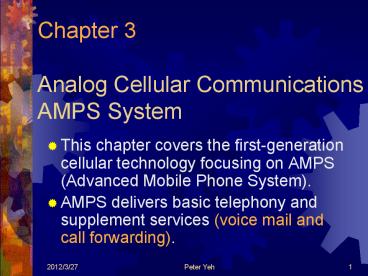Chapter 3 Analog Cellular Communications AMPS System PowerPoint PPT Presentation
1 / 33
Title: Chapter 3 Analog Cellular Communications AMPS System
1
Chapter 3Analog Cellular Communications AMPS
System
- This chapter covers the first-generation cellular
technology focusing on AMPS (Advanced Mobile
Phone System). - AMPS delivers basic telephony and supplement
services (voice mail and call forwarding).
2
Network Elements
- The AMPS specification refers to terminals as
mobile stations and to base station as land
stations. - The common terminology for an AMPS switch is
mobile telephone switching office (small and
large MTSO). - The communication links between the base stations
and switch are labeled land lines (copper wires,
optical fibers or microwave systems)
3
(No Transcript)
4
AMPS Identification Codes
- Mobile Identification Number (MIN)
- Area code (3 digits), Exchange number (3 digits)
and subscriber number (4 digits) - Electronic Serial Number (ESN)
- System Identifier (SID)
- Station Class Mark (SCM)
- Indicates capabilities of a mobile station
- Supervisory Audio Tone (SAT)
- Digital Color Code (DCC)
- Help mobile stations distinguish neighboring base
stations from one another
5
Frequency Bands and Physical Channels
- The band for forward transmissions, from cell
site to mobile station, is 870-890 MHz. - The reverse band, for transmissions by mobiles,
is 45 MHz lower. - An AMPS physical channel occupies two 30 KHz
frequency bands, one for each direction.
6
(No Transcript)
7
Radiated Power
- An AMPS terminal is capable of radiating signals
at 6 or 8 different power levels (6 mW to 4W). - 10 log 4000 36 dBm
- The radiated power at a a base station is
typically 25 W. - Discontinuous transmission (DTX)
- Speech activity detector
- ON-OFF state
- Power saving and Interference reducing
8
Analog Signal Processing
- Compression and pre-emphasis are established
techniques for audio signal transmission. - An amplitude limiter confines the maximum
excursions of the frequency modulated signal to
12 KHz. - Low pass filter Attenuates signal components at
frequencies above 3 KHz, refer to Fig. 3.5. - The notch (at 6KHz) removes signal energy at the
frequencies associated with the 3 SAT of the AMPS
system.
9
(No Transcript)
10
(No Transcript)
11
(No Transcript)
12
SAT and ST
- The SAT (Supervisory Audio Tone) transmitted with
user information serves to identify the base
station assigned to a call. - Each base station has its own SAT- at 5970 Hz,
6000 Hz, or 6030 Hz. - An analog signals from AMPS terminals can also
contain a 10 KHz sine wave referred to as a ST
(Supervisory Tone). - On-hook and Off-hook indications signaling
- The channel reuse principles (Section 9.3.2)
13
Digital Signals
- AMPS also transmits important network control
information in digital form. - AMPS digital signal are sine waves either 8 KHz
above or 8 KHz below the carrier. - The signal format is Manchester coded binary
frequency shift keying at a rate of 10 Kbps
14
(No Transcript)
15
Spectrum Efficiency
- Frequency modulation in 30 KHz physical channels
- Signal-to-Interference ratio (SIR)
- SIR gt (SIR)req 18 dB
- Reuse factor N 7 (Figure 9.9)
- Spectrum efficiency
- E395 /725 2.26 conversations/cell/MHz
- 395 traffic channels, 25 MHz/system, 7 cells in a
cluster
16
(No Transcript)
17
Logical Channel Categories
- FOCC Forward (Downlink) Control Channel
- Carries the same information from one base
station to all of the mobile terminals
(Broadcast) - RECC Reverse (Uplink) Control Channel
- Carries information from many mobile terminals
that do not have voice channel (Random access) - FVC Forward Voice Channel (Dedicated)
- RVC Reverse Voice channel (Dedicated)
- Forward and reverse traffic channel
- User information (Dedicated)
18
(No Transcript)
19
(No Transcript)
20
(No Transcript)
21
(No Transcript)
22
(No Transcript)
23
(No Transcript)
24
(No Transcript)
25
(No Transcript)
26
Tasks Performed by Terminals
- Initialization mode
- The terminal turns the power on
- A conversation ends
- Loses contact with the current base station
- Idle mode
- Access mode (from Idle mode)
- The terminal presses the SEND button
- An incoming call request detected (MIN)
- A registration event stimulated
- Conversation mode
27
(No Transcript)
28
(No Transcript)
29
(No Transcript)
30
(No Transcript)
31
Capacity
- There are 3 ways to increase the capacity
- Operate with smaller cells
- Obtain additional spectrum allocations
- Improve spectrum efficiency
- NAMPS (Narrowband-AMPS)
- Messages similar to AMPS
- Synchronization sequences
- Digital versions of the SAT and ST
32
(No Transcript)
33
Review Exercises
- What is the purpose of the busy / idle bits in
the FOCC? Why are they not used in the other
control channel formats? - Explain how the AMPS system users supervisory
audio tones (SAT) and a digital color code (DCC).
Why are both required? - Explain why it is sometimes desirable for the
AMPS system to set up a call through a base
station that is not the nearest base station to
the terminal. How does the AMPS system achieve
this effect?

